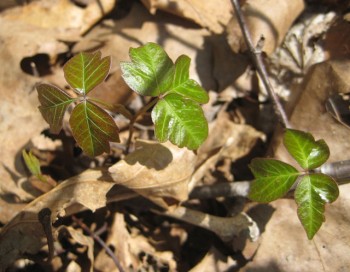
One of the things I noticed about foraging in New England that does not present a problem here at 11,000 feet in the Colorado High Country is the seeming ever-presence of poison ivy (Toxicondendron radicans). One morning, overjoyed to find false Solomon’s seal (Maianthemum sp.) growing in abundance in the forest around my parents’ Connecticut house, I borrowed a trowel and headed out to dig up some rhizomes, only to find each and every plant intricately intertwined with poison ivy.
Poison ivy is not edible. And, unless you are one of the lucky few not (yet) allergic to T. radicans, coming in contact with it can instigate a blistering, itchy rash. I know first-hand how potent the roots can be, having developed a nasty case after a day digging in the not-yet-leafing-out plants as an archaeology student in college. My hands and arms were so bad that the Health Services department insisted I had contracted scabies. Inhaling fumes is a thousand times worse—the unlucky sap who accidentally burns it in a campfire and then huffs the stuff should be rushed to the hospital immediately, as the rash can develop internally throughout the body as well.
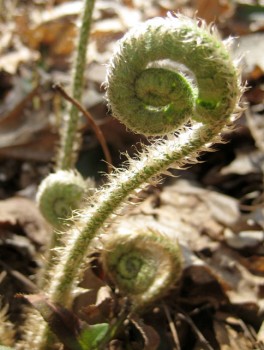
Poison ivy is distinguished by “long-stalked, alternate, three-parted palmate-compound leaves” wherein “one leaflet points to the left, one to the right, and one has a stem and points straight ahead” according to Steve Brill (1994) in Identifying and Harvesting Edible and Medicinal Plants. The leaflets bear teethy indentations and are “dark glossy-green” with “red overtones” in spring and fall. Poison ivy grows low on the ground, in shrub-like form, and as a vine on trees.
Guilty by Association?
I stared at the false Solomon’s seal plants, happily cavorting about with their toxic neighbors, in dismay. If I could get by the threat of contact dermatitis unscathed, I wondered, and then adequately separate edible roots from the itchy-pain causing ones, was there still a chance poison ivy had contaminated the false Solomon’s seal roots by virtue of proximity?
Better safe than sorry, I concluded, abandoning the edible root-bearers to the care of their shiny-leaved guardians.
Later, deep into a quest for ostrich fern (Matteucia struthiopteris) fiddleheads in New Hampshire, my sister found the supposed objects of my desire in a swampy bog and eagerly set about gathering them before noticing that they, too, were intermingled with young specimens of poison ivy. Unwilling to simply toss out my long-sought find, I left my bag of fiddleheads in her refrigerator for several days while contemplating my next move.
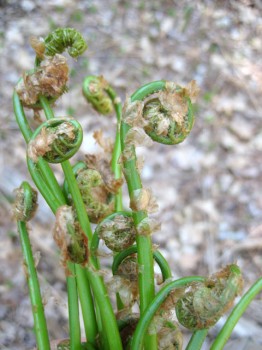
Roots were one thing, but would poison ivy leaves taint above ground vegetables merely by growing nearby? I perused the wild food literature, and although I found several entries regarding the dangers of T. radicans, not one (in my possession) specifically addressed the question of eating other plants growing in proximity.
In Stalking the Wild Asparagus (1962) Euell Gibbons recounts a radical immunity-building technique whereby a person eats three new poison ivy leaves of spring when they first appear, repeating this practice each day (thereby gradually increasing the dose) for three weeks. Although the famed wild edible plants author tried it himself without incident, I never will—and I wouldn’t recommend you do it either.
But I did wonder this: If it were remotely possible to eat three small leaves of poison ivy safely, then how risky would it be to eat fern fiddleheads whose sole crime was to grow near young specimens of the offending weed?
Damn You, Inedible Fiddleheads!
In and of itself, fern fiddlehead edibility is a widely confused matter, I discovered in Thayer (The Forager’s Harvest, 2006). Many believe cinnamon fern (Osmunda cinnamomea) fiddleheads to be edible, while other sources say that they are not. Thayer conducted two experiments on himself to test non-ostrich-fern edibility. First he and a friend consumed a serving of interrupted fern (Osmunda claytonia), thereupon experiencing “severe headaches, nausea, dizziness, lethargy, and general malaise.” A later test with cinnamon fern (Osmunda cinnamomea) yielded similar but milder symptoms.
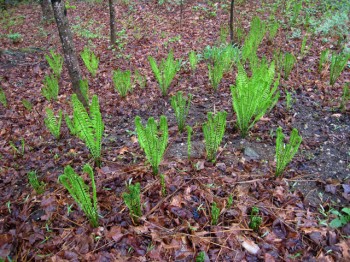
The Osmunda fern fiddleheads both bear a fuzzy or woolly coating, which I used to distinguish them from the sought-after Matteucia’s in my hunt. After many fuzzy disappointments, I was elated to find non-fuzz-bearing fiddleheads with my sister, so you can imagine I did not look forward to forgoing the fuzz-less fiddleheads on poison ivy grounds.
Still, I had yet come to a decision about whether or not to consume them when it came time to depart her house for my uncle’s to the north. My uncle—the man who introduced me to wild edible plants many years back—has ostrich ferns growing on a dark hillside that descends to a floodplain beside a small river. Although many are the occasions on which he’s extolled their virtues, not before this trip have I made it to his house while they were in season.
I was surprised to find it took a little convincing to get him to share, as he’d invited “a horde of foragers” a day prior to chow down on fiddleheads with him, but in the end he invited us to collect a side dish’s worth. They didn’t look much like the meager fiddleheads my sister and I’d found down south. Their glowing, green-gold forms lit up the dark forest, a veritable enchanted garden of dreamy delicacies. Mostly I gathered the broken, unnoticed fiddleheads from the previous day’s assault and mom did the same on the floodplain I couldn’t reach due to my recently-reconstructed knee. We stir fried the ostrich fern fiddleheads with garlic, asparagus, and sweet orange peppers and they were an absolute delight; I can see why people go gaga over them.
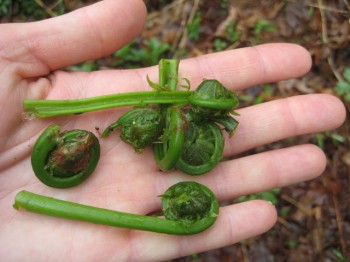
The next day, while out walking with my uncle, I kept trying to identify new patches in the hopes of sourcing some fiddleheads beyond his backyard. I found some powdery-stalked specimens—different from his, which were dark green, but Thayer indicates that the ostrich presents in both a dark green and powdery form. My uncle did not believe me, however, and it was not until a spirited rereading of Thayer’s chapter that I rediscovered a telltale feature that distinguishes ostrich ferns from the others: “The stalk of the frond has a deep, U-shaped groove running its entire length on the top (the side facing the center of the rosette), similar to the groove in a celery stalk.”
No, my powdery finds were not ostrich ferns—and as it turns out, nor were the poison-ivy-seasoned fiddleheads in my sister’s refrigerator either!
I daresay New England is lucky for all that poison ivy—if only to keep would-be foragers like myself from making unfortunate mistakes.
NOTE: If anyone has any experience eating poison ivy-tainted wild veggies, please do share. Inquiring minds want to know how that turned out for you.

Mustard Garlic soon, with pix!
I would eat em, as long as they are cooked, without any qualms. We are OVERRUN with poison ivy and I am crazy reactive to it. When foraging, it’s unavoidable here so I wear gloves, lots of clothes, shower, and immediately wash my clothes when I get home. *Everything* I pick lives next to poison ivy – I haven’t had a problem eating anything, tho I wouldn’t pick something and then eat it raw.
I was taught that poison ivy leaves are indeed edible when the are young, before they produce enough urushiol to give you a problem. Having been a poorly supervised and perpetually hungry child who routinely traipsed barefoot through Maryland’s lush thickets of T. radicans with little to no reaction, I’m surprised I never got around to nibbling it.
Useful.
The pictured “smooth NH fiddleheads” seem to have a groove on the side facing the center of the rosette. Is that groove not deep enough to identify them as ostrich ferns? Did you find a name for them?
Hi Dave,
Well it was a long time ago that I took that photo, forgive me, but I recall no groove and I don’t see what you are seeing in the picture. I don’t know for sure what type of fern that is but I can circle back when I know more. Sincerely, Erica